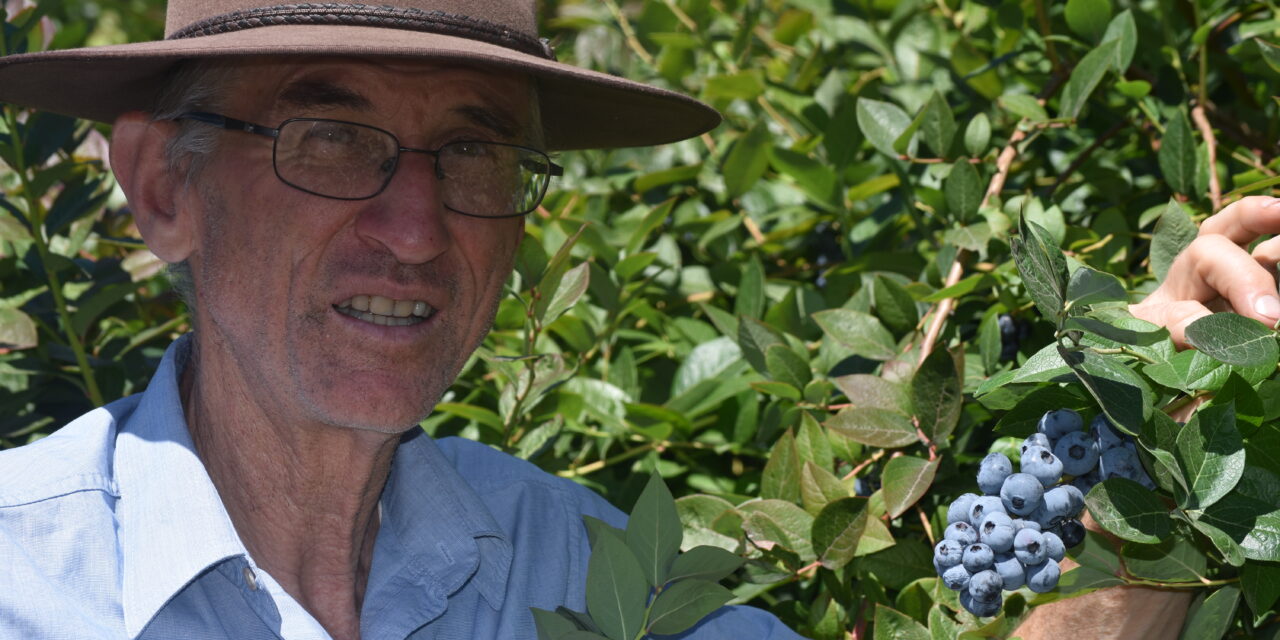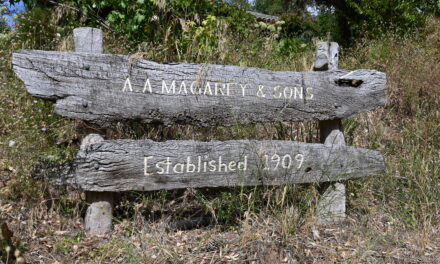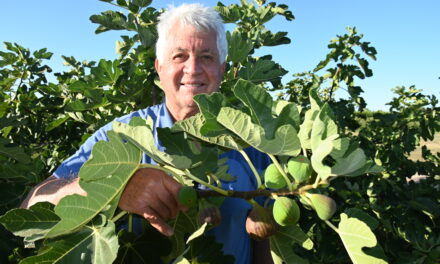Wayne Knight likes to mingle with people at markets, especially those that say they don’t like blueberries. He’s on a mission to change their minds, writes RICK BAYNE.
In addition to his role as the major shareholder and director of Otway Blueberries, Wayne Knight sells blueberries off his private adjoining Gellibrand farm at the Apollo Bay market.
“It’s important to keep in touch with the consumer and what they want,” he said.
Lately, he has found more people saying they don’t like blueberries, though he quickly converts them by letting them taste one of his home-grown treats.
“It’s striking how many more people are saying they don’t like blueberries, but it’s impossible not to like these ones,” Wayne said.
However, he understands why the reputation of blueberries as being tasty and healthy treats has taken a bit of a battering.
Commercial blueberries started in Victoria, but northern NSW is now the main producer.
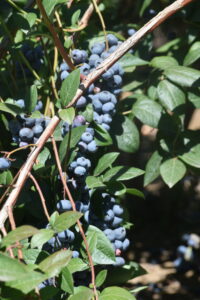
Otway Blueberries grows and sells Brigitta and Northland varieties.
There are three species of blueberries grown in Australia.
Victoria and Tasmania grow Northern Highbush (native to the north of the United States), northern NSW grows Southern Highbush, which are evergreen and native to southern states of the US.
Then there is the third species, commonly called Rabbiteye blueberries.
The deciduous Northern Highbush has a fruiting season in summer and autumn, the evergreen Southern Highbush fruits in winter and spring.
This gives Australians fresh blueberries for most of the year.
However, the Rabbiteye blueberries are recently being grown in northern NSW to extend the NSW season to overlap the Victorian months of December, January and February.
“Rabbiteye blueberries are highly inferior in flavour and texture and if people have only eaten these, they could well think that they don’t like blueberries,” Wayne said.
“This is happening because the supermarkets have had a massive amount of Rabbiteye for sale the past few years. They are cheap and nasty.
“In other countries growers have got together, realising that Rabbiteyes are destroying the market and stopped growing them.
“By crashing the wholesale market in Victoria with the huge volume of Rabbiteyes, small Victorian growers cannot get prices that they need to survive.”
Blueberries are also becoming cheaper due to competition from New Zealand.
“The prices we are getting now aren’t as high as they were 10 years ago,” Wayne said.
“There are more growers and more volume and supply has come up to meet demand. The price was high when everyone wanted them and hardly anyone was growing them.”
Otway Blueberries grows and sells Brigitta and Northland varieties.
“Brigitta is the best variety you can grow in Victoria, but it has a relatively short season and then we move to Northland,” Wayne said.
“There are about 80 different species of blueberries … but ours are the best.”
Wayne, 70, grew up in Kilmore and studied at Burnley Horticultural College.
Today he looks after customers at Otway Blueberries, while his daughter Lisa looks after the pickers around her profession as an osteopath.
Otway Blueberries supplies several independent customers, with three refrigerated trucks delivering to Melbourne, Geelong and the Surf Coast, and the 6.5ha site is open to pick your own.
“We also send to wholesale markets that will probably end up in supermarkets,” Wayne said.
“I don’t deal with supermarkets because our fruit can be fairly old before they manage to get it in the store. With our own customers, it can be picked today and in their shops by the next morning.
“If I had a choice, I wouldn’t wholesale, it would be all pick-your-own, but we’re 180 kilometres from Melbourne, although we still bring a lot of people to town.”
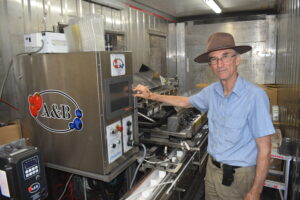
Wayne Knight in the automated packing room.
After graduating, Wayne worked for five years as an arborist before buying land in Gellibrand.
He still owns that original site, while the adjoining Otway Blueberries land belongs to the company.
He lived in New Zealand for a year and returned to Australia with a dream of growing kiwi fruit.
However, meeting Ridley Bell, widely known as the father of the blueberry industry in Australia, changed his direction.
“Ridley was studying small fruits and suggested I grow blueberries down here. Kiwi fruit don’t like hot, dry summers. New Zealand is perfect for them; here is not,” Wayne said.
“Ridley got seed in from the US and grew thousands of seedlings and selected the best; Brigitta was the most successful. I was the first person to buy plants from his backyard nursery in about 1981.”
Before this there were a few blueberry trees, but it wasn’t a commercial industry.
“They were just seedlings. What we grow now are asexually propagated clones so they are all identical. Seedlings vary too much and aren’t marketable,” Wayne said.
Ridley later moved to northern NSW and was the main driver in founding that part of the industry.
Wayne studied growing blueberries and found the soil at Gellibrand was incredibly suitable.
“Blueberries are a heathland plant and this is heathland. It’s acid soil and they like acid soil. That’s where they naturally grow,” he said.
Blueberries belong to the Ericaceae family and are related to azaleas and rhododendrons.
“The local plants that grow in this area are in the same family as blueberries,” Wayne said.
“There’s no doubt the mycorrhizal fungi that lived on the roots of those plants get into the blueberry roots.
“That’s why they thrive here. They don’t have normal root hairs and need the fungal association on the roots to take in nutrients.”
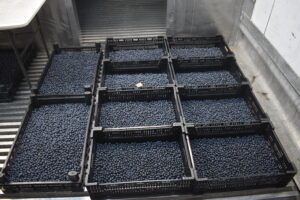
A cool room keeps blueberries fresh for distribution across the region and into Melbourne.
The varieties grown by Otway Blueberries come from North America.
“As a horticulturalist, I knew they liked sandy soil to grow,” Wayne said.
“This is Cranbourne loam and underneath is black sand. I wanted that soil because I knew you could grow just about anything, you just have to add things, particularly magnesium.
“We don’t have to add much — they don’t have high requirements for nutrients. We add calcium in the form of gypsum which doesn’t raise the pH levels from 4.5 which is ideal for our purposes.”
While Wayne has grown blueberries on his farm since 1981, he discovered the site had a well-known fungus and put the plants on ice for 20 years and became a nurseryman.
However, the reputation of blueberries continued to grow.
“No matter what was wrong with you, blueberries could fix it,” Wayne said.
“Blueberries suddenly took off and became very popular. We had 300 plants at my place on a quarter of an acre — I was the only one supplying the Melbourne wholesale market.
“A friend suggested we put in more and we ended up with these 16 acres planted in 2005.”
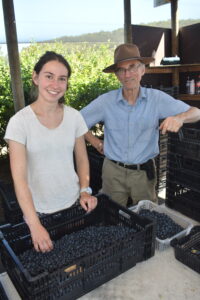
Wayne Knight with one of his employees, Rachel Chapman, who is a backpacker on a working visa.
Otway Blueberries was the biggest grower in Victoria for 10 years and is still second biggest, though less than a quarter of the major player.
“There are plans to expand by 25 per cent in the next year.
“We could sell more if we had them,” Wayne said.
It’s not hard selling blueberries; they’re sweet and pretty addictive — they don’t fill you so you keep eating them.”
It cost $1 million to set up 20 years ago to convert poorly maintained agricultural land and add drainage, irrigation, netting and infrastructure.
Drainage was essential.
“If they are inundated by flood for a couple of days it kills them,” Wayne said.
“Blueberry roots are near the surface and inhabit the high organic matter on the bottom of the mulch.
“If you don’t have good drainage, you will fail, and it’s the same with netting.
“A lot have tried and failed but most blueberry growers don’t have a horticultural education which does help.”
Otway Blueberries is pesticide-free and has had no major problems with insect damage.
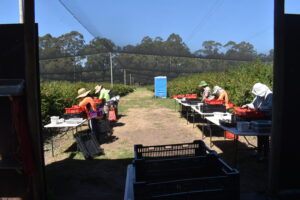
About 20 backpackers are hired as pickers during the season.
On an early year they pick before Christmas, but usually don’t start until the first week of the new year and sell into April, even May on rare occasions.
There are about 20 backpackers for the picking season and two staff work the rest of the year to prune the 35,000 trees and spread mulch.
It’s not hard to find backpackers and there is a lot of on-site accommodation.
“Picking blueberries is pleasant, not like blackberries or mangoes,” Wayne said.
“Pickers think they’ve died and gone to heaven when they come here.”
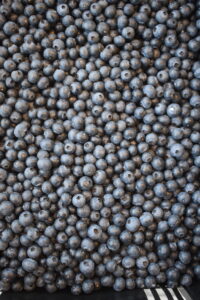
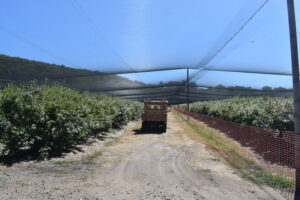
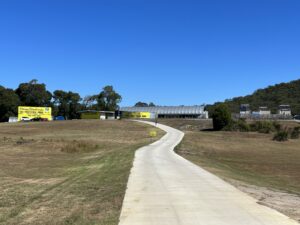
Otway Blueberries in south-western Victoria.

